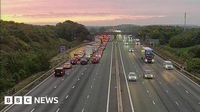Early morning commuters along the M1 in Bedfordshire faced significant delays on Saturday, September 27, 2025, after a car overturned, bringing southbound traffic to a complete standstill. The incident, which forced the closure of all four lanes between junction 14 for Milton Keynes and junction 13 for Bedford, sparked a swift response from emergency services and left hundreds of vehicles queued for hours as authorities scrambled to clear the scene and restore the vital motorway link.
According to BBC News, the chaos began when a single vehicle flipped over just before dawn, prompting National Highways to announce the immediate closure of the southbound carriageway. The closure, which stretched across a key section of one of Britain’s busiest roads, led to long tailbacks as drivers found themselves stuck in gridlock, their journeys abruptly interrupted by the unexpected turn of events. Images shared by National Highways on X (formerly Twitter) showed three lanes thick with stationary traffic, while the opposite side of the motorway remained eerily empty—a stark visual reminder of the disruption unfolding in real time.
Bedfordshire police, fire services, and the East of England Ambulance Service were all quickly dispatched to the scene, working together to manage the fallout from the accident. According to National Highways, diversions were put in place to help ease the congestion, with traffic being rerouted off the motorway and onto local roads. For many, however, the morning commute was already lost to the delays, as emergency responders worked methodically to ensure the safety of everyone involved and clear the wreckage.
“All four lanes of the southbound carriageway were closed in Bedfordshire between junction 14 for Milton Keynes and junction 13 for Bedford,” National Highways confirmed on X, underscoring the scale of the disruption. The decision to close the entire southbound section was not taken lightly, but officials emphasized that the safety of motorists and rescue personnel was the top priority. The closure created a cascading effect on traffic throughout the region, as drivers sought alternative routes and local roads became clogged with diverted vehicles.
While the precise details of how the car came to overturn remain unclear, the swift and coordinated response from emergency services helped prevent further incidents. Bedfordshire police arrived on the scene first, securing the area and directing traffic away from the site of the accident. Firefighters from the local brigade worked to ensure there were no hazards from leaking fuel or damaged infrastructure, while the East of England Ambulance Service stood by to provide medical assistance if needed. Fortunately, there were no immediate reports of serious injuries, though the full circumstances of the crash are still under investigation.
For those caught in the resulting traffic jam, the experience was one of frustration and uncertainty. Many drivers reported being stuck for over an hour as the queue stretched back for miles. Social media quickly filled with images and accounts from stranded motorists, some expressing concern about missing important appointments or being late for work. Others praised the professionalism of the emergency services, noting the calm and orderly manner in which the incident was managed.
“Diversions were put in place during the closure,” National Highways reiterated, reminding drivers to follow the marked routes and avoid attempting to rejoin the motorway before it was declared safe. The organization also urged patience, acknowledging the inconvenience but stressing that the measures were necessary to protect everyone on the road. For those unfamiliar with the area, the diversion routes proved challenging, with some drivers reporting confusion as they navigated unfamiliar backroads and congested town centers.
The closure and subsequent reopening of the M1 southbound carriageway highlight the ongoing challenges faced by Britain’s motorway network, particularly during peak travel times. The M1, which stretches from London to Leeds, is a critical artery for both local and long-distance traffic. Any disruption, especially on a busy Saturday morning, can have widespread repercussions—not just for individual drivers, but for businesses, delivery services, and emergency responders relying on the motorway for rapid transit.
By 08:15 BST, the road was finally reopened, much to the relief of those who had been waiting in the backlog. According to the BBC, the quick work of emergency crews and traffic management teams allowed the motorway to return to normal operations with minimal damage to the road surface or surrounding infrastructure. As vehicles began to move again, a palpable sense of relief spread through the queue, with many drivers expressing gratitude that the incident had not resulted in more serious consequences.
In the aftermath, questions remain about what can be done to prevent similar incidents in the future. While overturned vehicles are not uncommon on busy motorways, the impact of such accidents is often compounded by the sheer volume of traffic and the lack of immediate alternative routes. Some transportation experts have called for increased investment in road safety measures, including better signage, improved barriers, and enhanced driver education programs. Others point to the need for more robust communication systems to keep drivers informed in real time and reduce the likelihood of secondary accidents caused by sudden stops or confusion during diversions.
For local residents and regular users of the M1, Saturday’s incident is a reminder of the unpredictable nature of road travel and the importance of staying alert behind the wheel. While the exact cause of the overturned car is still being determined, the quick response from Bedfordshire police, fire services, and the East of England Ambulance Service undoubtedly helped contain the situation and prevent further harm.
As traffic flows returned to normal and the last of the emergency vehicles departed, the motorway bore little trace of the morning’s upheaval. Yet for those caught in the jam, the experience will linger as a testament to the fragility of even the most well-maintained infrastructure. With diversions lifted and all four lanes once again open, the M1 resumed its role as a vital link in the nation’s transport network—at least until the next unexpected twist in the road.




